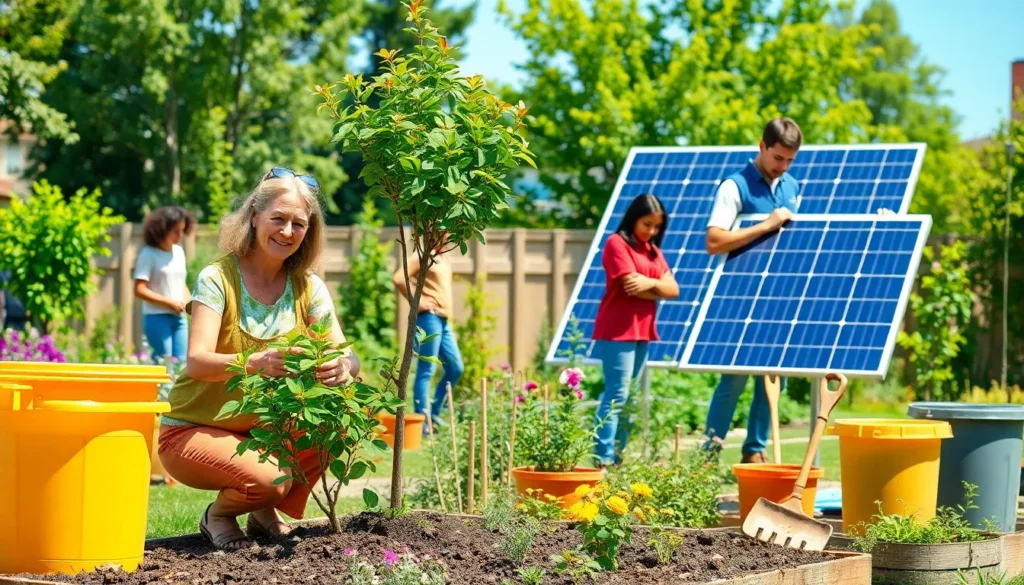Table of Contents
ToggleSustainable living isn’t just a trendy buzzword; it’s a lifestyle choice that can save the planet while making life a lot more interesting. Imagine reducing your carbon footprint and feeling like a superhero at the same time. Who wouldn’t want to swap out plastic straws for bamboo ones and feel like they’re saving the world one sip at a time?
What Does Sustainable Living Mean?
Sustainable living refers to a lifestyle aimed at reducing an individual’s or society’s use of Earth’s natural resources. Emphasizing eco-friendly choices, it seeks to create a balance between meeting current needs and preserving resources for future generations. Making informed decisions can lead to less waste and a greater conservation of biodiversity.
This approach integrates practices like reducing waste, conserving energy, and supporting local economies. Individuals may choose to prioritize products with minimal packaging or organic materials. Adopting a plant-based diet is another effective method that not only promotes health but also lowers carbon output associated with meat production.
Sustainable living encourages using renewable energy sources such as solar, wind, or hydro power. Residents can install solar panels on their homes, decreasing reliance on fossil fuels. Water conservation techniques, such as using rain barrels or low-flow fixtures, further contribute to sustainability efforts.
In addition to individual actions, community involvement plays an essential role in promoting sustainable living. Participating in local clean-up events or supporting community gardens enhances environmental education and fosters a sense of collective responsibility. Awareness campaigns and workshops can assist in spreading knowledge about best practices.
Ultimately, sustainable living is a continuous journey toward greater environmental harmony, encouraging thoughtful consumption and active participation in the planet’s future. Making small changes can empower individuals to affect significant positive changes in their communities and beyond.
Principles of Sustainable Living

Sustainable living encompasses several core principles that guide individuals and communities toward ecological balance.
Environmental Responsibility
Environmental responsibility involves making choices that protect and preserve natural ecosystems. Individuals practicing this principle tend to reduce waste by recycling and composting materials. Choosing energy-efficient appliances directly lowers energy consumption and carbon emissions. Supporting local farmers who adopt organic farming techniques promotes biodiversity and minimizes chemical usage. Individuals can also prioritize sustainable transportation methods, such as biking or using public transit, to decrease greenhouse gas emissions. By taking these actions, they actively contribute to a healthy planet.
Social Equity
Social equity focuses on ensuring equal access to resources and opportunities for all individuals. This principle encourages communities to support fair labor practices, ensuring workers receive fair wages and safe working conditions. Embracing diversity and inclusivity within local initiatives strengthens social bonds. Accessible education about sustainable practices helps empower marginalized communities. Engagement in social justice movements can bridge gaps between economic status and environmental awareness. A commitment to social equity leads to a more balanced and just society.
Economic Viability
Economic viability supports the creation of systems that promote sustainability while ensuring economic growth. This principle emphasizes investing in renewable energy sources that create jobs and reduce reliance on fossil fuels. Supporting local businesses stimulates the economy and fosters community resilience. Prioritizing sustainable products encourages companies to adopt ethical practices and lower their environmental impact. Encouraging innovation in green technologies can lead to long-term economic benefits. Engaging in sustainable investing supports projects that align financial growth with ecological responsibility.
Benefits of Sustainable Living
Sustainable living offers numerous benefits for individuals, communities, and the environment. Embracing eco-friendly practices enhances overall well-being, fosters savings, and strengthens community ties.
Health Benefits
Adopting sustainable living practices contributes to improved health. Fresh, organic produce often contains fewer pesticides and chemicals, leading to better nutrition. Using eco-friendly products reduces exposure to harmful substances in households. Engaging in outdoor activities, such as gardening or participating in local clean-ups, promotes physical fitness. Additionally, choosing plant-based diets may decrease the risk of chronic diseases, strengthening long-term health.
Economic Savings
Economic savings arise from sustainable living choices. Reducing energy consumption through efficient appliances lowers utility bills. Buying local products supports community businesses and often costs less than purchasing imported goods. Minimizing waste by reusing and recycling decreases disposal costs. Investing in renewable energy sources, like solar panels, leads to long-term financial benefits through reduced energy expenses. Shifting to sustainable transportation options also cuts fuel costs, enhancing overall savings.
Community Impact
Sustainable living positively impacts local communities. Participating in community gardens fosters connections among residents, enhances food security, and encourages collaboration. Promoting local economies through sustainable practices supports job creation. Collective efforts, such as organizing recycling or clean-up events, inspire environmental awareness and responsibility. Educating others about sustainable habits cultivates a culture of sustainability and stewardship. Encouraging participation in environmentally-friendly initiatives leads to a stronger, more resilient community.
Challenges of Sustainable Living
Sustainable living presents several challenges that individuals and communities must navigate. Understanding these obstacles helps promote awareness and solutions.
Common Misconceptions
Many believe sustainable living requires drastic lifestyle changes, leading to reluctance. They think reducing waste means giving up convenience entirely, which is not accurate. Misunderstandings about eco-friendly products often arise, suggesting they are more expensive or less effective. In reality, various sustainable options exist across price ranges, making them accessible. Some individuals also assume that sustainable living is strictly for the affluent or environmentally conscious, whereas it benefits everyone. Public education on these misconceptions can encourage broader adoption of sustainable practices.
Practical Barriers
Practical barriers hinder the implementation of sustainable living for many people. Limited access to sustainable products creates challenges, especially in food deserts. Urban areas may lack sufficient transportation for local markets, making sourcing difficult. Time constraints pose another problem, as busy schedules often lead to convenience-oriented choices. Financial pressures may influence decisions, making cheaper, non-sustainable options more appealing. Utilities and infrastructure also factor in; areas with unreliable recycling programs struggle to encourage participation. Addressing these barriers requires community collaboration and resource allocation to create sustainable solutions.
Tips for Practicing Sustainable Living
Sustainable living involves making conscious choices that benefit the environment. Here are some practical tips to incorporate into daily life.
Everyday Choices
Opting for reusable products significantly reduces waste. Choosing glass or stainless steel containers instead of plastic ones helps mitigate pollution. Selecting locally sourced food supports regional economies while minimizing transportation emissions. Composting organic waste returns nutrients to the soil and decreases landfill contributions. Finding energy-efficient appliances lowers electricity consumption and costs, fostering responsible resource management. Prioritizing eco-friendly products means reading labels to ensure minimal packaging and sustainable materials. Embracing a vegetarian or vegan diet lowers an individual’s carbon footprint and promotes health benefits.
Community Involvement
Joining local environmental groups encourages collective action toward sustainability. Participating in community clean-ups enhances public spaces and raises awareness about environmental issues. Supporting community gardens creates green spaces, boosts food security, and fosters connections among neighbors. Attending workshops on sustainable practices empowers individuals with knowledge and skills for eco-friendly living. Collaborating with nearby businesses to promote sustainable initiatives cultivates local engagement and economic resilience. Volunteering for conservation projects strengthens community bonds while actively restoring natural habitats. Contributing to local environmental campaigns amplifies collective efforts toward a healthier, more sustainable world.
Sustainable living is a transformative approach that empowers individuals to make choices that benefit both themselves and the planet. By embracing eco-friendly practices and supporting local economies, people can contribute to a healthier environment and stronger communities.
The journey toward sustainability involves continuous learning and adaptation. With every small action taken, such as reducing waste or conserving energy, individuals can create a significant impact.
Ultimately, sustainable living isn’t just about individual choices; it’s about fostering a collective commitment to a more equitable and environmentally responsible future. Each step taken toward sustainability helps build a legacy of stewardship for generations to come.







